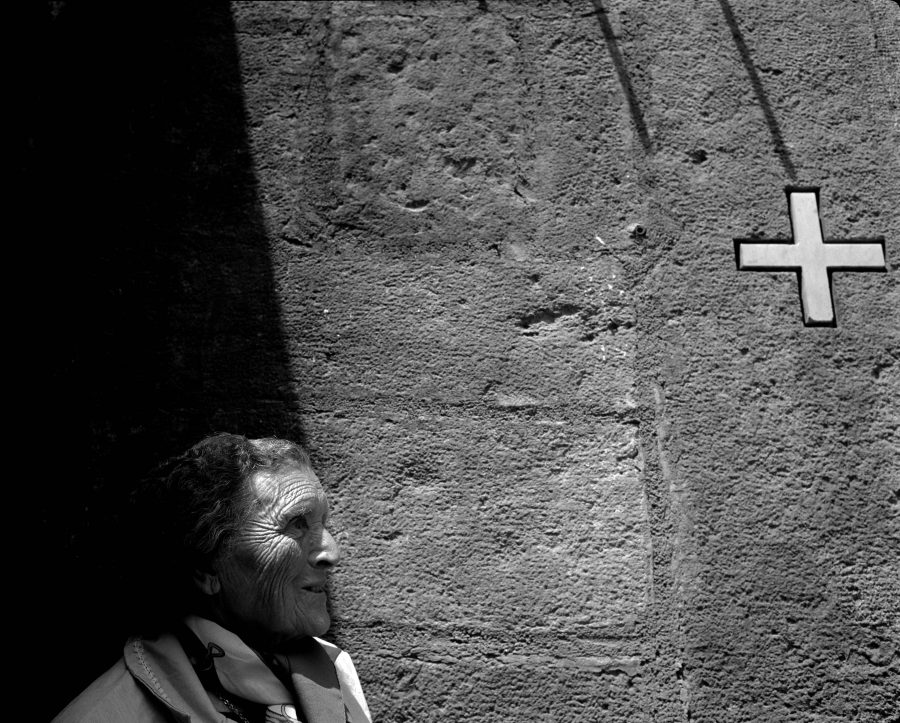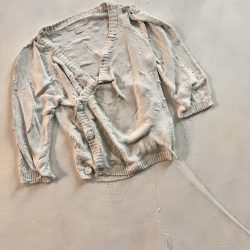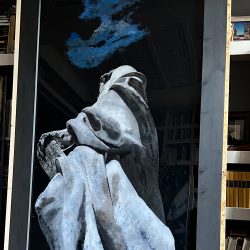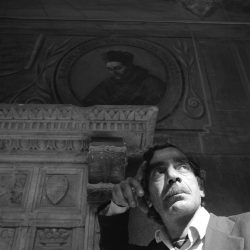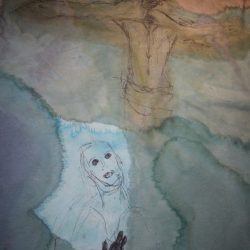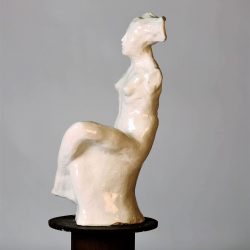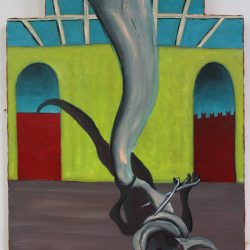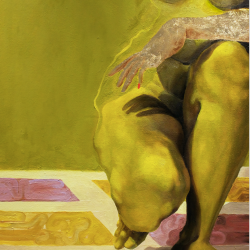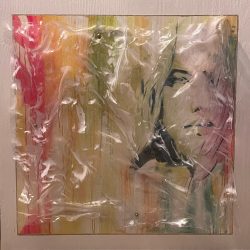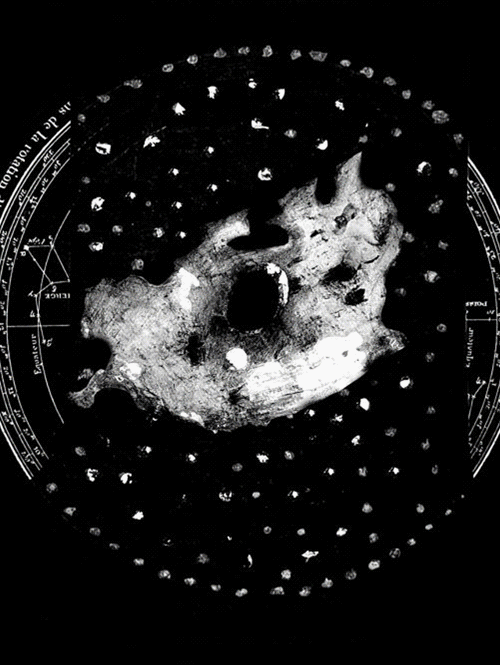work
CARNE DI PIPERNO
"Carne di Piperno" si inserisce in una tradizione artistica che intreccia documentazione visiva e speculazione metaforica, costruendo un dialogo tra la materia inanimata della pietra e la fragile temporalità della carne umana. Scattata a Napoli, città di contrasti e stratificazioni culturali, l’immagini si articolano intorno a due elementi chiave: i volti dei "neapolitans" su muri di piperno, solcati da segni del tempo e impreziositi da elementi non moderni, luci ed ombre. Il titolo stesso allude a una fusione tra organico e inorganico, tra ciò che è vivo e ciò che persiste, evocando l’eterno ciclo della vita e della memoria.
Il progetto si distingue per un uso sapiente del bianco e nero, che non è un semplice espediente estetico, ma una chiave interpretativa che amplifica il contrasto tra luce e ombra, tra la plasticità del volto umano e la superficie scabra del piperno. L’anziana donna è collocata sulla sinistra dell’inquadratura, in una zona parzialmente oscurata, come se emergesse da una penombra atemporale. I volti, spesso segnati da rughe profonde, si specchiano idealmente nella rugosità della pietra, in un gioco di risonanze materiche che sottolinea l’analogia tra pelle e roccia: entrambe portano i segni del tempo, entrambe narrano storie sedimentate.
Elementi simbolici architettonici di forte impatto, sono spesso posizionati in una zona di piena luce/ombra, quasi a fungere da contrappunto simbolico alla figura umana. Il muro di piperno, con la sua texture porosa e i segni dell’erosione, diventa una metafora della città stessa: Napoli, che si erode e si rigenera, che conserva la memoria di chi l’ha attraversata.
Nel contesto di una mostra fotografica, "Carne di Piperno" può essere letta come un’opera che interroga il rapporto tra corpo e spazio, tra memoria individuale e memoria collettiva. La scelta di accostare la figura umana a un elemento architettonico non è casuale: il muro diventa testimone silenzioso della storia, una pelle urbana che dialoga con la pelle vissuta della donna ritratta.
Curatorialmente, queste immagini si inseriscono perfettamente in un percorso espositivo che indaga il tema dell'identità e della permanenza: il volto del "neapolitan" rappresenta la memoria vivente della città, mentre il piperno racconta una storia millenaria di costruzione e resistenza ed il suo sguardo, rivolto verso l’esterno della scena, suggerisce un’apertura, una continuità tra passato e futuro .
La fotografia potrebbe trovare spazio in mostre dedicate al rapporto tra uomo e città, alla trasformazione urbana, o alle stratificazioni culturali di Napoli. Potrebbe essere accostata a opere di Mimmo Jodice, che ha spesso esplorato il tema delle vestigia archeologiche in relazione alla vita contemporanea, oppure inserita in un dialogo con artisti che lavorano sulla materia come Alberto Burri, laddove la pelle del muro richiama le crettature della sua Cretto.
Da un punto di vista sociologico, "Carne di Piperno" offre una riflessione sulla relazione tra individuo e contesto urbano, tra memoria personale e storia collettiva. Napoli è una città che si definisce attraverso le sue stratificazioni: ogni pietra, ogni muro porta i segni delle generazioni che vi hanno vissuto, così come i volti dei suoi abitanti raccontano storie di resistenza, sopravvivenza e trasformazione.
I protagonisti delle fotografie incarnano la memoria storica della città, una memoria che non è solo scritta nei libri, ma è vissuta nei corpi, nei gesti, nelle espressioni di chi l’abita. Le loro presenze all’interno delle immagini suggeriscono una Napoli che non è solo città-museo, ma organismo vivente, che si nutre del passato per proiettarsi nel futuro.
Il piperno, materiale largamente utilizzato nell’architettura partenopea, diventa qui un simbolo di continuità. È la pietra delle chiese, dei palazzi nobiliari, ma anche delle strade e dei vicoli, e in queste immagini assume un valore quasi antropologico: è la "carne" della città, un tessuto urbano che respira, che si logora ma che resiste.
Non ultima, suggerisce infine una riflessione sulla spiritualità radicata nella vita quotidiana napoletana. La fede a Napoli non è mai solo trascendenza, ma è incorporata negli spazi urbani, nelle edicole votive, nei simboli che punteggiano la città e sembra voler fissare un punto di riferimento in un mondo in perenne trasformazione.
"Carne di Piperno" è un’opera che vive della sua ambiguità interpretativa: è un ritratto umano e insieme un paesaggio urbano, è una riflessione sulla materia e un’indagine sulla transitorietà della vita. La sua forza sta nella capacità di sintetizzare, in un solo scatto, la complessa dialettica tra ciò che è effimero e ciò che è eterno, tra la pelle del vivente e la pelle della città.
Nel contesto di una mostra, queste immagini si prestano a molteplici letture e connessioni, diventando non solo una unica "opera fotografica", ma un frammento di un discorso più ampio sulla memoria, sulla resistenza e sulla condizione umana. La rappresentazione, quindi, di quella fotografia che chiede di essere guardata con attenzione, perché dentro le sue ombre e le sue luci risuonano secoli di storia e di vita.
"Carne di Piperno" is part of an artistic tradition that intertwines visual documentation and metaphorical speculation, constructing a dialogue between the inanimate matter of stone and the fragile temporality of human flesh. Shot in Naples, a city of contrasts and cultural stratifications, the images revolve around two key elements: the faces of "Neapolitans" on piperno walls, marked by the passage of time and adorned with non-modern elements, lights, and shadows. The title itself alludes to a fusion between the organic and the inorganic, between what is alive and what persists, evoking the eternal cycle of life and memory.
The project stands out for its masterful use of black and white, which is not merely an aesthetic device but an interpretative key that amplifies the contrast between light and shadow, between the plasticity of the human face and the rough surface of piperno. The elderly woman is positioned on the left side of the frame, in a partially shadowed area, as if emerging from an atemporal penumbra. The faces, often marked by deep wrinkles, ideally mirror the roughness of the stone, creating a play of material resonances that highlights the analogy between skin and rock: both bear the signs of time, both narrate sedimented stories.
Architectural elements of strong symbolic impact are often placed in areas of full light or deep shadow, almost serving as a symbolic counterpoint to the human figure. The piperno wall, with its porous texture and signs of erosion, becomes a metaphor for the city itself: Naples, which erodes and regenerates, which preserves the memory of those who have passed through it.
In the context of a photography exhibition, **"Carne di Piperno"** can be read as a work that questions the relationship between body and space, between individual memory and collective memory. The choice to juxtapose the human figure with an architectural element is not accidental: the wall becomes a silent witness to history, an urban skin that interacts with the lived-in skin of the portrayed woman.
Curatorially, these images fit perfectly into an exhibition path that explores themes of identity and permanence: the face of the "Neapolitan" represents the living memory of the city, while piperno tells a millennia-old story of construction and resilience. Her gaze, directed beyond the frame, suggests an openness, a continuity between past and future.
The photograph could find its place in exhibitions dedicated to the relationship between humans and the city, to urban transformation, or to the cultural stratifications of Naples. It could be juxtaposed with the works of Mimmo Jodice, who has often explored the theme of archaeological vestiges in relation to contemporary life, or placed in dialogue with artists working with material, such as Alberto Burri, where the wall’s surface recalls the cracks of his **Cretto**.
From a sociological perspective, **"Carne di Piperno"** offers a reflection on the relationship between individuals and their urban environment, between personal memory and collective history. Naples is a city defined by its layers: every stone, every wall carries the marks of the generations that have lived there, just as the faces of its inhabitants tell stories of resistance, survival, and transformation.
The protagonists of these photographs embody the historical memory of the city— a memory not just written in books but lived in bodies, gestures, and expressions of those who inhabit it. Their presence within the images suggests a Naples that is not just a museum-city but a living organism, one that feeds on its past to project itself into the future.
Piperno, a material widely used in Neapolitan architecture, becomes here a symbol of continuity. It is the stone of churches, noble palaces, but also of streets and alleys, and in these images, it takes on an almost anthropological value: it is the "flesh" of the city, an urban fabric that breathes, that wears down but endures.
Lastly, the work suggests a reflection on the spirituality embedded in everyday Neapolitan life. Faith in Naples is never purely transcendental; it is incorporated into urban spaces, in votive shrines, in symbols that punctuate the city, as if seeking to establish a reference point in a world in perpetual transformation.
**"Carne di Piperno"** is a work that thrives on its interpretative ambiguity: it is both a human portrait and an urban landscape, a reflection on materiality and an investigation into the transience of life. Its strength lies in its ability to synthesize, in a single shot, the complex dialectic between the ephemeral and the eternal, between the skin of the living and the skin of the city.
In the context of an exhibition, these images lend themselves to multiple interpretations and connections, becoming not just a single **"photographic work"**, but a fragment of a broader discourse on memory, resilience, and the human condition. A representation of that kind of photography that demands to be looked at carefully, because within its shadows and lights, centuries of history and life resonate.
120 b/w negative with Plaubel Makina 67 camera printed on photographic paper
Il progetto si distingue per un uso sapiente del bianco e nero, che non è un semplice espediente estetico, ma una chiave interpretativa che amplifica il contrasto tra luce e ombra, tra la plasticità del volto umano e la superficie scabra del piperno. L’anziana donna è collocata sulla sinistra dell’inquadratura, in una zona parzialmente oscurata, come se emergesse da una penombra atemporale. I volti, spesso segnati da rughe profonde, si specchiano idealmente nella rugosità della pietra, in un gioco di risonanze materiche che sottolinea l’analogia tra pelle e roccia: entrambe portano i segni del tempo, entrambe narrano storie sedimentate.
Elementi simbolici architettonici di forte impatto, sono spesso posizionati in una zona di piena luce/ombra, quasi a fungere da contrappunto simbolico alla figura umana. Il muro di piperno, con la sua texture porosa e i segni dell’erosione, diventa una metafora della città stessa: Napoli, che si erode e si rigenera, che conserva la memoria di chi l’ha attraversata.
Nel contesto di una mostra fotografica, "Carne di Piperno" può essere letta come un’opera che interroga il rapporto tra corpo e spazio, tra memoria individuale e memoria collettiva. La scelta di accostare la figura umana a un elemento architettonico non è casuale: il muro diventa testimone silenzioso della storia, una pelle urbana che dialoga con la pelle vissuta della donna ritratta.
Curatorialmente, queste immagini si inseriscono perfettamente in un percorso espositivo che indaga il tema dell'identità e della permanenza: il volto del "neapolitan" rappresenta la memoria vivente della città, mentre il piperno racconta una storia millenaria di costruzione e resistenza ed il suo sguardo, rivolto verso l’esterno della scena, suggerisce un’apertura, una continuità tra passato e futuro .
La fotografia potrebbe trovare spazio in mostre dedicate al rapporto tra uomo e città, alla trasformazione urbana, o alle stratificazioni culturali di Napoli. Potrebbe essere accostata a opere di Mimmo Jodice, che ha spesso esplorato il tema delle vestigia archeologiche in relazione alla vita contemporanea, oppure inserita in un dialogo con artisti che lavorano sulla materia come Alberto Burri, laddove la pelle del muro richiama le crettature della sua Cretto.
Da un punto di vista sociologico, "Carne di Piperno" offre una riflessione sulla relazione tra individuo e contesto urbano, tra memoria personale e storia collettiva. Napoli è una città che si definisce attraverso le sue stratificazioni: ogni pietra, ogni muro porta i segni delle generazioni che vi hanno vissuto, così come i volti dei suoi abitanti raccontano storie di resistenza, sopravvivenza e trasformazione.
I protagonisti delle fotografie incarnano la memoria storica della città, una memoria che non è solo scritta nei libri, ma è vissuta nei corpi, nei gesti, nelle espressioni di chi l’abita. Le loro presenze all’interno delle immagini suggeriscono una Napoli che non è solo città-museo, ma organismo vivente, che si nutre del passato per proiettarsi nel futuro.
Il piperno, materiale largamente utilizzato nell’architettura partenopea, diventa qui un simbolo di continuità. È la pietra delle chiese, dei palazzi nobiliari, ma anche delle strade e dei vicoli, e in queste immagini assume un valore quasi antropologico: è la "carne" della città, un tessuto urbano che respira, che si logora ma che resiste.
Non ultima, suggerisce infine una riflessione sulla spiritualità radicata nella vita quotidiana napoletana. La fede a Napoli non è mai solo trascendenza, ma è incorporata negli spazi urbani, nelle edicole votive, nei simboli che punteggiano la città e sembra voler fissare un punto di riferimento in un mondo in perenne trasformazione.
"Carne di Piperno" è un’opera che vive della sua ambiguità interpretativa: è un ritratto umano e insieme un paesaggio urbano, è una riflessione sulla materia e un’indagine sulla transitorietà della vita. La sua forza sta nella capacità di sintetizzare, in un solo scatto, la complessa dialettica tra ciò che è effimero e ciò che è eterno, tra la pelle del vivente e la pelle della città.
Nel contesto di una mostra, queste immagini si prestano a molteplici letture e connessioni, diventando non solo una unica "opera fotografica", ma un frammento di un discorso più ampio sulla memoria, sulla resistenza e sulla condizione umana. La rappresentazione, quindi, di quella fotografia che chiede di essere guardata con attenzione, perché dentro le sue ombre e le sue luci risuonano secoli di storia e di vita.
"Carne di Piperno" is part of an artistic tradition that intertwines visual documentation and metaphorical speculation, constructing a dialogue between the inanimate matter of stone and the fragile temporality of human flesh. Shot in Naples, a city of contrasts and cultural stratifications, the images revolve around two key elements: the faces of "Neapolitans" on piperno walls, marked by the passage of time and adorned with non-modern elements, lights, and shadows. The title itself alludes to a fusion between the organic and the inorganic, between what is alive and what persists, evoking the eternal cycle of life and memory.
The project stands out for its masterful use of black and white, which is not merely an aesthetic device but an interpretative key that amplifies the contrast between light and shadow, between the plasticity of the human face and the rough surface of piperno. The elderly woman is positioned on the left side of the frame, in a partially shadowed area, as if emerging from an atemporal penumbra. The faces, often marked by deep wrinkles, ideally mirror the roughness of the stone, creating a play of material resonances that highlights the analogy between skin and rock: both bear the signs of time, both narrate sedimented stories.
Architectural elements of strong symbolic impact are often placed in areas of full light or deep shadow, almost serving as a symbolic counterpoint to the human figure. The piperno wall, with its porous texture and signs of erosion, becomes a metaphor for the city itself: Naples, which erodes and regenerates, which preserves the memory of those who have passed through it.
In the context of a photography exhibition, **"Carne di Piperno"** can be read as a work that questions the relationship between body and space, between individual memory and collective memory. The choice to juxtapose the human figure with an architectural element is not accidental: the wall becomes a silent witness to history, an urban skin that interacts with the lived-in skin of the portrayed woman.
Curatorially, these images fit perfectly into an exhibition path that explores themes of identity and permanence: the face of the "Neapolitan" represents the living memory of the city, while piperno tells a millennia-old story of construction and resilience. Her gaze, directed beyond the frame, suggests an openness, a continuity between past and future.
The photograph could find its place in exhibitions dedicated to the relationship between humans and the city, to urban transformation, or to the cultural stratifications of Naples. It could be juxtaposed with the works of Mimmo Jodice, who has often explored the theme of archaeological vestiges in relation to contemporary life, or placed in dialogue with artists working with material, such as Alberto Burri, where the wall’s surface recalls the cracks of his **Cretto**.
From a sociological perspective, **"Carne di Piperno"** offers a reflection on the relationship between individuals and their urban environment, between personal memory and collective history. Naples is a city defined by its layers: every stone, every wall carries the marks of the generations that have lived there, just as the faces of its inhabitants tell stories of resistance, survival, and transformation.
The protagonists of these photographs embody the historical memory of the city— a memory not just written in books but lived in bodies, gestures, and expressions of those who inhabit it. Their presence within the images suggests a Naples that is not just a museum-city but a living organism, one that feeds on its past to project itself into the future.
Piperno, a material widely used in Neapolitan architecture, becomes here a symbol of continuity. It is the stone of churches, noble palaces, but also of streets and alleys, and in these images, it takes on an almost anthropological value: it is the "flesh" of the city, an urban fabric that breathes, that wears down but endures.
Lastly, the work suggests a reflection on the spirituality embedded in everyday Neapolitan life. Faith in Naples is never purely transcendental; it is incorporated into urban spaces, in votive shrines, in symbols that punctuate the city, as if seeking to establish a reference point in a world in perpetual transformation.
**"Carne di Piperno"** is a work that thrives on its interpretative ambiguity: it is both a human portrait and an urban landscape, a reflection on materiality and an investigation into the transience of life. Its strength lies in its ability to synthesize, in a single shot, the complex dialectic between the ephemeral and the eternal, between the skin of the living and the skin of the city.
In the context of an exhibition, these images lend themselves to multiple interpretations and connections, becoming not just a single **"photographic work"**, but a fragment of a broader discourse on memory, resilience, and the human condition. A representation of that kind of photography that demands to be looked at carefully, because within its shadows and lights, centuries of history and life resonate.
120 b/w negative with Plaubel Makina 67 camera printed on photographic paper



